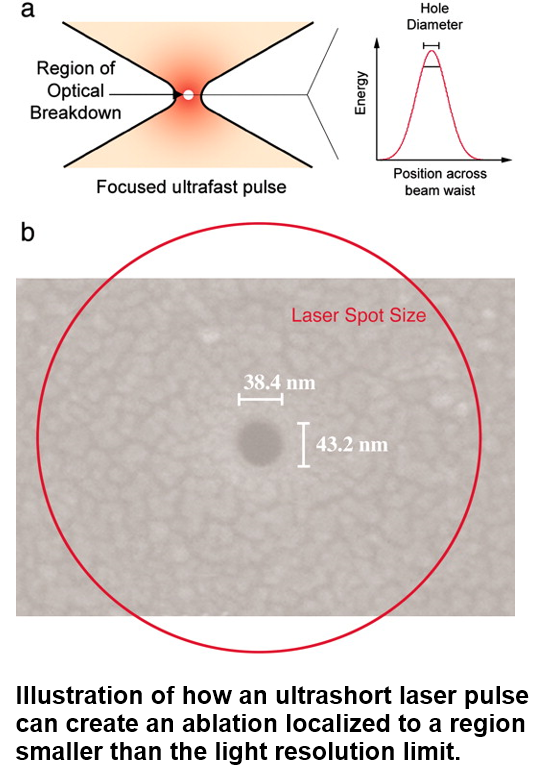
Ultrafast science is the study and subsequent implementation of physical phenomena that occur at the shortest time scales known in science, from picoseconds to femtoseconds to attoseconds. Snapshots in this time domain reveal the most fundamental mechanisms of molecular, atomic, and electron interactions. Ultrafast science enables us to answer such questions as how molecules move in liquids or gases, how electrons collide in semiconductors and superconductors, and how light initiates the vision process.
The Center for Ultrafast Optical Science (CUOS) at the University of Michigan was chartered to advance the scientific and technological applications of ultrashort optical pulses. The heart of the Center is its unique combination of state-of-the-art short-pulse and high-intensity lasers, capable of generating peak powers up to 300 trillion Watts. Their operating principle, Chirped-Pulse Amplification (CPA), was developed by CUOS scientists. The tremendous peak power, generated by a laser which rests on a single table-top, is contained in bursts of laser light that are less than 100 femtoseconds in duration. That’s only .0000000000001 seconds, or far less time that it takes for light to travel the thickness of a sheet of paper. A supersonic aircraft travels less than the diameter of an atom in this time!
Ultrafast is Ultrashort. These unique lasers enable us to examine and to understand phenomena that occur on “ultrashort” time scales. For example, these lasers can freeze the motion of atoms in a vibrating molecule. They can even resolve the rapid tiny motion of electrons within a single atom, which form the foundation of quantum chemistry and physics. Powerful ultrashort light pulses can modify surfaces in new ways. This may lead to new materials, and new opto-electronic devices which operate at unprecedented speeds.
CUOS has also developed techniques to sculpt these short laser pulses, to alter their color and amplitude to high precision. The shaped pulses of light are tools that can be used to engineer new quantum structures in atoms and molecules. The ultimate aim is to control atomic and molecular processes in gases, liquids, and plasmas for purposes ranging from materials processing to light-source production to particle acceleration.
Ultrafast is Ultra-precise. Short bursts of energetic laser light have many surprising properties that can lead to a variety of novel applications. For instance, materials which are normally optically transparent become opaque. Thus, micro-machining or incisions can be made beneath the surface of some materials, without damaging the surface of the medium. This concept of “ultra-precise” materials processing led researchers at the Center to consider using ultrafast lasers as surgical tools. Specifically, CUOS scientists are working on Ophthalmologic applications. Various types of eye surgery may be significantly improved by replacing the traditional scalpel or laser, with an ultrafast laser. Researchers have already demonstrated that the quality of an incision made by an ultrafast laser is greater than those produced by conventional lasers. New surgical techniques which are only possible using ultrafast lasers are presently under investigation. This research may lead to significantly improved eye care — surgery that once had to be performed in an operating room, could now place in a doctor’s office.
Not only can these lasers cut, but they are powerful imaging tools as well. At least three different areas of microscopy are presently pursued at the Center. These microscopes can be used to image and examine important biological systems or materials, or to study the path of electrical current through microchips operating at high speeds.
Ultrafast is Ultra-broad. X-rays have revolutionized medicine, science and technology. Bright, coherent ultrashort flashes of X-rays can take movies of proteins, pathogens and nanostructures, giving insight into their workings.
Despite the demand, only a few dedicated Synchrotron facilities exit worldwide, partially due the size and cost of conventional accelerator and wiggler technology. Here, at CUOS we have shown that X-rays of a quality similar to 3rd generation Synchrotrons can be obtained in a university scale laboratory, on a spatial scale of millimeters rather than tens of meters of conventional light sources, using a 100 Terawatt laser focused into a gas. This scheme has recently demonstrated high quality beams of electrons. The generated plasma wave that accelerates the electrons can also wiggle them. Operating in the non-linear regime, this yields a high quality X-ray beam, which is spatially coherent, emanates from a micron-sized source, has 10-100 keV photon energy, milliradian divergence, ten femtosecond duration and a peak brightness of up to 1022 ph/s/mrad2/mm2/0.1%BW, which is comparable to 3rd generation Synchrotrons. The measured radiation is spatially coherent, opening up a multitude of applications, such as phase contrast and lensless imaging, previously only possible with large conventional light sources. The concept of the laser plasma wiggler has the potential of making novel radiation sources more compact, economical and abundant, and thus impacting progress all across science and technology.
Ultrafast is Ultra-intense. Chirped-Pulse Amplification is a method for producing lasers of unprecedented intensity. Our most intense laser produces pulses which exceed 300 Terawatts (300 trillion Watts). During its short duration, the power in each pulse exceeds the total power generated in the United States by 300 times. The light can be focused to 2×1022 watts per square centimeter (2 with 22 zeroes or 20000 billion Watts per square centimeter), which considerably exceeds the intensity of any other radiation source on earth. These are sources for studying fundamental physics in a new regime. Beyond that, there are important technological benefits to these new light sources. CUOS scientists are studying advanced problems such as compact accelerators, broad-band light sources, and nonlinear plasma channeling effects.



